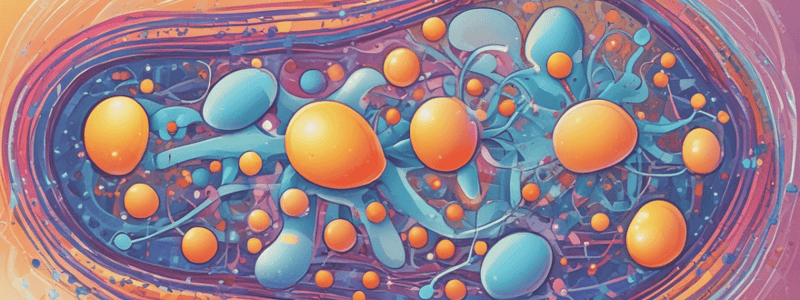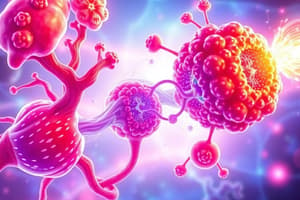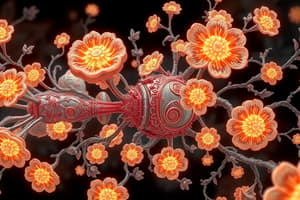Podcast
Questions and Answers
In which direction do electrons flow in the electron transport chain?
In which direction do electrons flow in the electron transport chain?
- Electrons do not flow in the electron transport chain
- From carriers with more positive E0 to more negative E0
- From carriers with more negative E0 to more positive E0 (correct)
- Randomly in both directions
What is the number of ATP molecules generated per NADH molecule using oxygen as the terminal electron acceptor?
What is the number of ATP molecules generated per NADH molecule using oxygen as the terminal electron acceptor?
- 3 ATP (correct)
- 5 ATP
- 4 ATP
- 2 ATP
What is the primary function of the proton gradient established during oxidative phosphorylation?
What is the primary function of the proton gradient established during oxidative phosphorylation?
- To generate ATP through chemiosmosis (correct)
- To reduce oxygen to water
- To pump protons out of the cell
- To facilitate the transport of electrons across the membrane
What is the mechanism by which ATP is generated from the energy released in the electron transport chain?
What is the mechanism by which ATP is generated from the energy released in the electron transport chain?
Which component of the F1Fo ATP Synthase is responsible for proton translocation?
Which component of the F1Fo ATP Synthase is responsible for proton translocation?
Which structure is responsible for generating ATP from the proton motive force?
Which structure is responsible for generating ATP from the proton motive force?
What is the process by which the energy from the proton motive force is used to drive ATP synthesis?
What is the process by which the energy from the proton motive force is used to drive ATP synthesis?
What is the result of proton movement back across the membrane during chemiosmosis?
What is the result of proton movement back across the membrane during chemiosmosis?
Which of the following is NOT a component of the bacterial electron transport chain?
Which of the following is NOT a component of the bacterial electron transport chain?
In which direction do protons flow during the electron transport chain?
In which direction do protons flow during the electron transport chain?
What is the direction of proton movement during the electron transport chain?
What is the direction of proton movement during the electron transport chain?
What is the net gain of ATP molecules per glucose molecule in cellular respiration?
What is the net gain of ATP molecules per glucose molecule in cellular respiration?
What is the function of the c subunit ring in the F1Fo ATP Synthase?
What is the function of the c subunit ring in the F1Fo ATP Synthase?
Which of the following is NOT a component of the electron transport chain?
Which of the following is NOT a component of the electron transport chain?
What is the electron transport chain responsible for generating?
What is the electron transport chain responsible for generating?
Where is the proton motive force generated during oxidative phosphorylation?
Where is the proton motive force generated during oxidative phosphorylation?
What is the function of the F1 subunit of the F1Fo ATP Synthase?
What is the function of the F1 subunit of the F1Fo ATP Synthase?
What is the result of the chemiosmotic hypothesis?
What is the result of the chemiosmotic hypothesis?
What is the final product of denitrification in anaerobic respiration?
What is the final product of denitrification in anaerobic respiration?
What is the purpose of the proton motive force in oxidative phosphorylation?
What is the purpose of the proton motive force in oxidative phosphorylation?
Which of the following is NOT a component of the electron transport chain in bacteria?
Which of the following is NOT a component of the electron transport chain in bacteria?
What is the function of the rotating ring of c subunits in the F1Fo ATP synthase?
What is the function of the rotating ring of c subunits in the F1Fo ATP synthase?
What is the basis of the Nitrite Strip Test for urinary tract infections?
What is the basis of the Nitrite Strip Test for urinary tract infections?
How many ATP molecules are generated per NADH using oxygen as the terminal electron acceptor?
How many ATP molecules are generated per NADH using oxygen as the terminal electron acceptor?
In which membrane is the electron transport chain found in bacteria?
In which membrane is the electron transport chain found in bacteria?
What is the chemiosmotic hypothesis?
What is the chemiosmotic hypothesis?
Flashcards are hidden until you start studying
Study Notes
Oxidative Phosphorylation
- Energy released during electron transport is used to establish a proton gradient and charge difference across the membrane.
- Proton motive force (PMF) drives ATP synthesis through the F1Fo ATP synthase.
- F1Fo ATP synthase is a multiprotein complex that uses proton movement to catalyze ATP synthesis.
F1Fo ATP Synthase
- In bacterial F1Fo ATP synthase, the proton channel is in the F0 subunit.
- Rotating ring of c subunits drives ATP synthesis.
Electron Transport Chain
- Electrons from NADH and FADH2 generated by the oxidation of organic substrates are transferred through a series of membrane-bound electron carriers.
- Electron carriers include cytochromes and quinones, and are found in the mitochondrial membrane in Eukarya and plasma membrane in Bacteria and Archaea.
- Electrons flow from carriers with more negative E0 to more positive E0, releasing energy used to make ATP by oxidative phosphorylation.
- 3 ATP can be generated per NADH using O2 as the terminal electron acceptor.
Anaerobic Respiration Example
- Denitrification: Nitrate (NO3-) as terminal electron acceptor, reduced to nitrogen gas (N2).
- Paracoccus denitrificans: Facultative anaerobe in soil, depletes soil N, lower crop yield.
- Escherichia coli: Facultative anaerobe, can use Nitrate as e- acceptor, Nitrate first reduced to Nitrite, basis of Nitrite Strip Test - diagnostic for Urinary Tract Infections (UTI).
TCA Cycle and Electron Transport
- Pyruvate is oxidized to form Acetyl CoA, releasing a CO2 and producing a high-energy thioester bond.
- TCA cycle produces more oxidations, forming NADH and FADH2.
- Net yield of 2 ATP molecules synthesized directly from the oxidation of glucose.
- Most ATP is made when NADH and FADH2 are oxidized in electron transport chains.
Studying That Suits You
Use AI to generate personalized quizzes and flashcards to suit your learning preferences.





